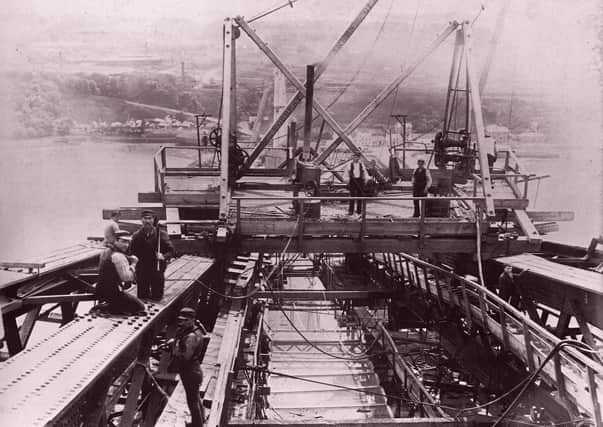Nostalgia: Spanning 130 years across the Firth of Forth


On March 4 1890, HRH The Prince of Wales opened the Forth Railway Bridge.
The ceremony ended years of construction by thousands of men and realised the dreams of the great rail barons of the age.
Advertisement
Hide AdAdvertisement
Hide AdFrom the moment its superstructure began to rise out of the sea, the bridge drew crowds in their thousands, and by the time it opened it was the most popular attraction in Scotland.
The Forth Bridge has never ceased to inspire wonder and affection and since its construction it has been used as a symbol of strength, reliability and performance to advertise everything from shortbread and stockings to banking systems and microelectronics.
Designed by Benjamin Baker, the bridge is one and a half miles long, and took seven years to build, using 54,000 tons of steel and 6,500,000 rivets.
At the height of the construction, a total of 4600 men were employed. Tragically 57 of them lost their lives and 461 were injured before the bridge was completed in February 1890.
Advertisement
Hide AdAdvertisement
Hide AdTwo rescue boats were permanently on hand as building work went on and eight men were rescued from the Forth as well as 8000 caps and other clothing dropped by the workers.
Almost all of the bridge was first built on shore to make sure everything fitted together before being assembled on site.
Finally, the eyes of the world turned to the Firth of Forth for the first time on March 4, 1890, when the Prince of Wales drove home the last of the rivets to join finally the north and south shores of the mighty waterway and unite the communities of Fife and Lothian.
The epic opening ceremony marked the beginning of an era of excellence, both for Scotland and Victorian engineering.
Advertisement
Hide AdAdvertisement
Hide AdIt’s construction was hailed by one of the newspapers of the time, the Daily Chronicle as an unsurpassed feat of engineering.
It said: “Never has there been a more complete triumph of man’s brain and muscle over the forces of nature, and the workmen engaged in its undertaking, many of whom lost their lives by their daring and their zeal, ought to be honoured as much as our soldiery who have won historic battles.”
However, the Morning Post cast doubts on the viability of the bridge, saying: “The commercial value of the bridge, from a railway point of view, must necessarily remain to be proved.
“The new line will undoubtedly meet with strenuous opposition, whose importance it would be unwise to discard.”
Advertisement
Hide AdAdvertisement
Hide AdAt the time, the bridge was the largest in the world, with the longest span, and was the first major bridge with a steel superstructure.
It has since become the blueprint for countless other bridges across the globe.
Such is its significance that in 1939 it was the target for the first attack of the Second World War on the British mainland by the German Luftwaffe.
A hit on the island of Inchgarvie, at the base of the bridge was mistaken as a direct hit on the structure, and the Forth Bridge survived to tell its tale.
Comment Guidelines
National World encourages reader discussion on our stories. User feedback, insights and back-and-forth exchanges add a rich layer of context to reporting. Please review our Community Guidelines before commenting.